Organisational Control: Bureaucratic and Cultural Control
VerifiedAdded on 2023/06/15
|10
|2836
|193
AI Summary
This essay discusses the benefits and challenges of bureaucratic and cultural control within an organisation. It also includes a reflective commentary on motivation from a management student's perspective.
Contribute Materials
Your contribution can guide someone’s learning journey. Share your
documents today.
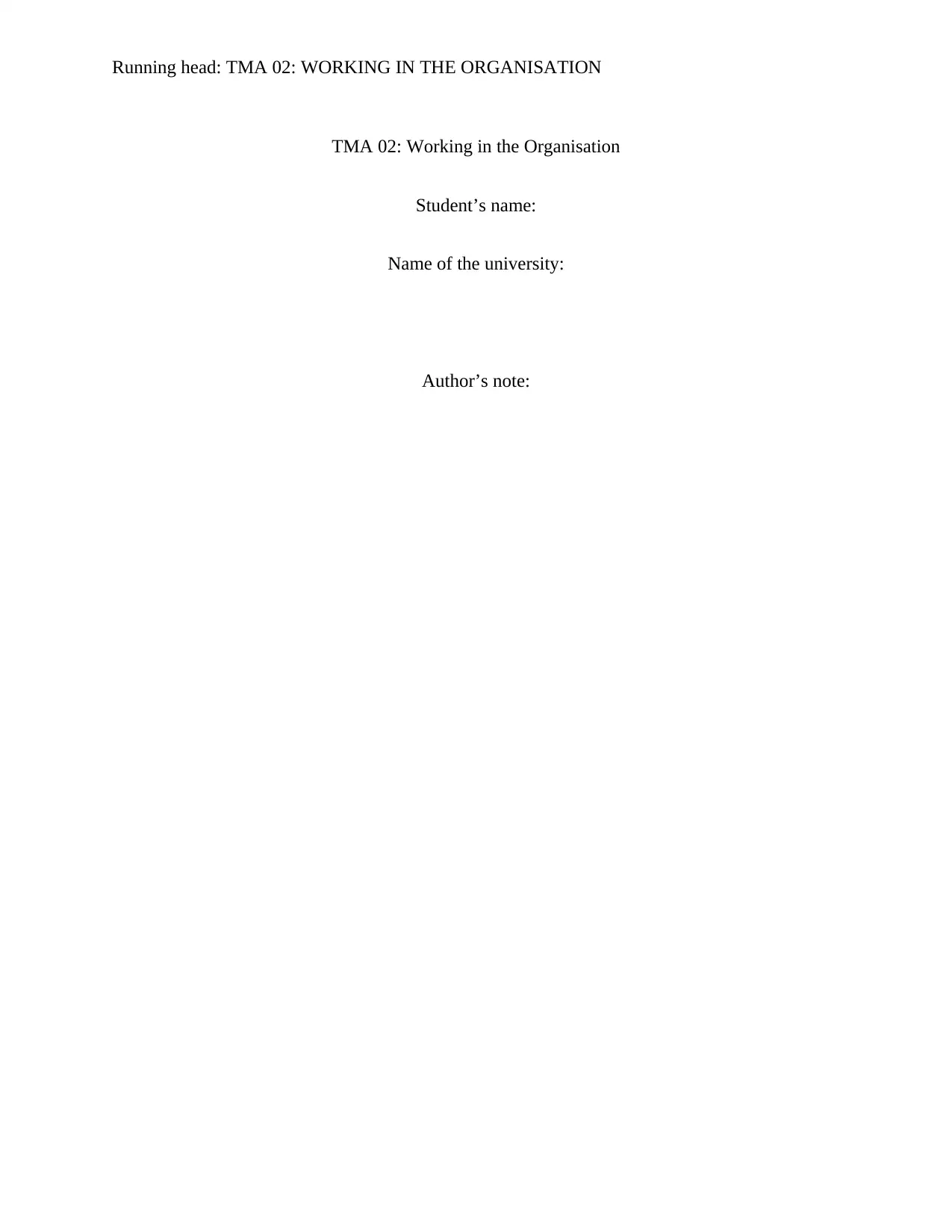
Running head: TMA 02: WORKING IN THE ORGANISATION
TMA 02: Working in the Organisation
Student’s name:
Name of the university:
Author’s note:
TMA 02: Working in the Organisation
Student’s name:
Name of the university:
Author’s note:
Secure Best Marks with AI Grader
Need help grading? Try our AI Grader for instant feedback on your assignments.
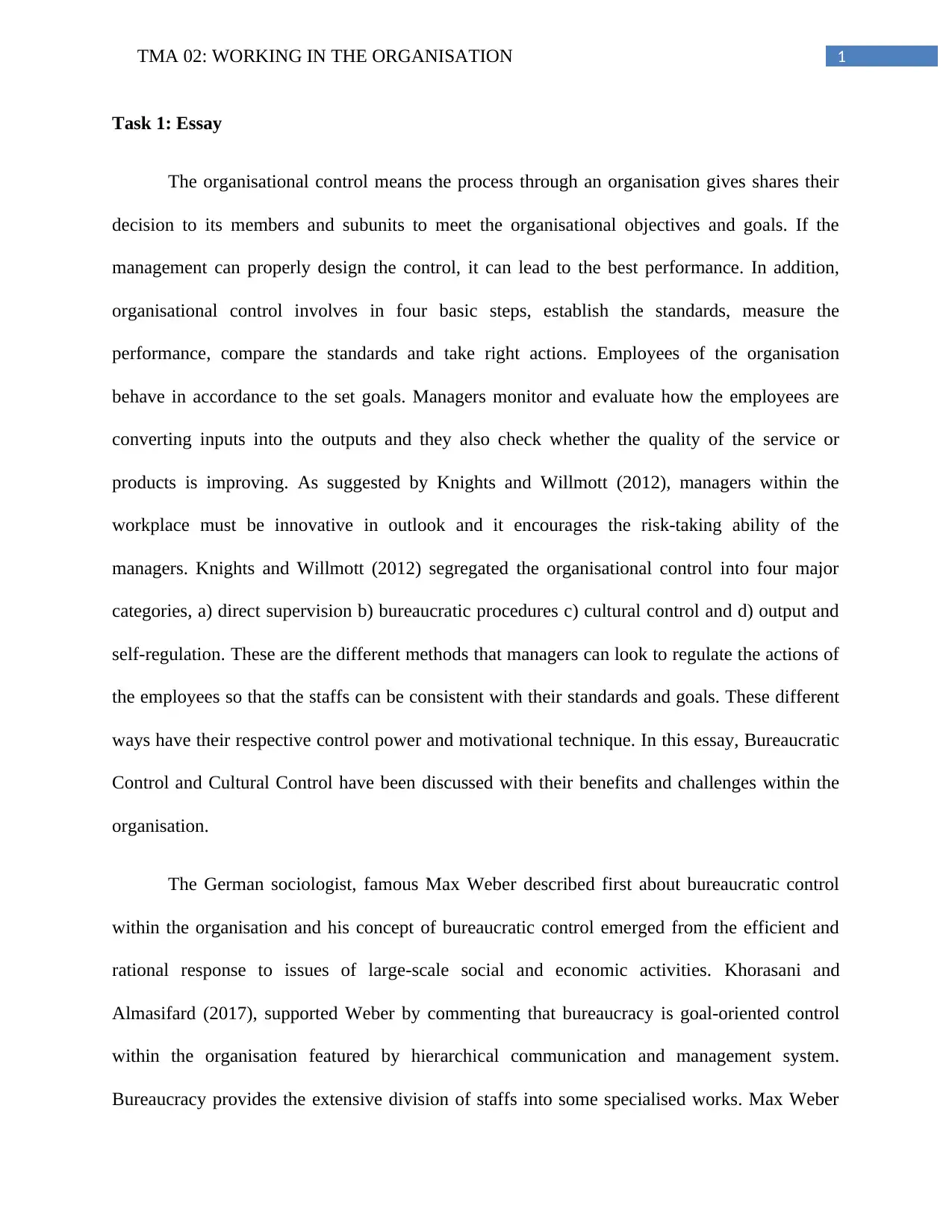
1TMA 02: WORKING IN THE ORGANISATION
Task 1: Essay
The organisational control means the process through an organisation gives shares their
decision to its members and subunits to meet the organisational objectives and goals. If the
management can properly design the control, it can lead to the best performance. In addition,
organisational control involves in four basic steps, establish the standards, measure the
performance, compare the standards and take right actions. Employees of the organisation
behave in accordance to the set goals. Managers monitor and evaluate how the employees are
converting inputs into the outputs and they also check whether the quality of the service or
products is improving. As suggested by Knights and Willmott (2012), managers within the
workplace must be innovative in outlook and it encourages the risk-taking ability of the
managers. Knights and Willmott (2012) segregated the organisational control into four major
categories, a) direct supervision b) bureaucratic procedures c) cultural control and d) output and
self-regulation. These are the different methods that managers can look to regulate the actions of
the employees so that the staffs can be consistent with their standards and goals. These different
ways have their respective control power and motivational technique. In this essay, Bureaucratic
Control and Cultural Control have been discussed with their benefits and challenges within the
organisation.
The German sociologist, famous Max Weber described first about bureaucratic control
within the organisation and his concept of bureaucratic control emerged from the efficient and
rational response to issues of large-scale social and economic activities. Khorasani and
Almasifard (2017), supported Weber by commenting that bureaucracy is goal-oriented control
within the organisation featured by hierarchical communication and management system.
Bureaucracy provides the extensive division of staffs into some specialised works. Max Weber
Task 1: Essay
The organisational control means the process through an organisation gives shares their
decision to its members and subunits to meet the organisational objectives and goals. If the
management can properly design the control, it can lead to the best performance. In addition,
organisational control involves in four basic steps, establish the standards, measure the
performance, compare the standards and take right actions. Employees of the organisation
behave in accordance to the set goals. Managers monitor and evaluate how the employees are
converting inputs into the outputs and they also check whether the quality of the service or
products is improving. As suggested by Knights and Willmott (2012), managers within the
workplace must be innovative in outlook and it encourages the risk-taking ability of the
managers. Knights and Willmott (2012) segregated the organisational control into four major
categories, a) direct supervision b) bureaucratic procedures c) cultural control and d) output and
self-regulation. These are the different methods that managers can look to regulate the actions of
the employees so that the staffs can be consistent with their standards and goals. These different
ways have their respective control power and motivational technique. In this essay, Bureaucratic
Control and Cultural Control have been discussed with their benefits and challenges within the
organisation.
The German sociologist, famous Max Weber described first about bureaucratic control
within the organisation and his concept of bureaucratic control emerged from the efficient and
rational response to issues of large-scale social and economic activities. Khorasani and
Almasifard (2017), supported Weber by commenting that bureaucracy is goal-oriented control
within the organisation featured by hierarchical communication and management system.
Bureaucracy provides the extensive division of staffs into some specialised works. Max Weber
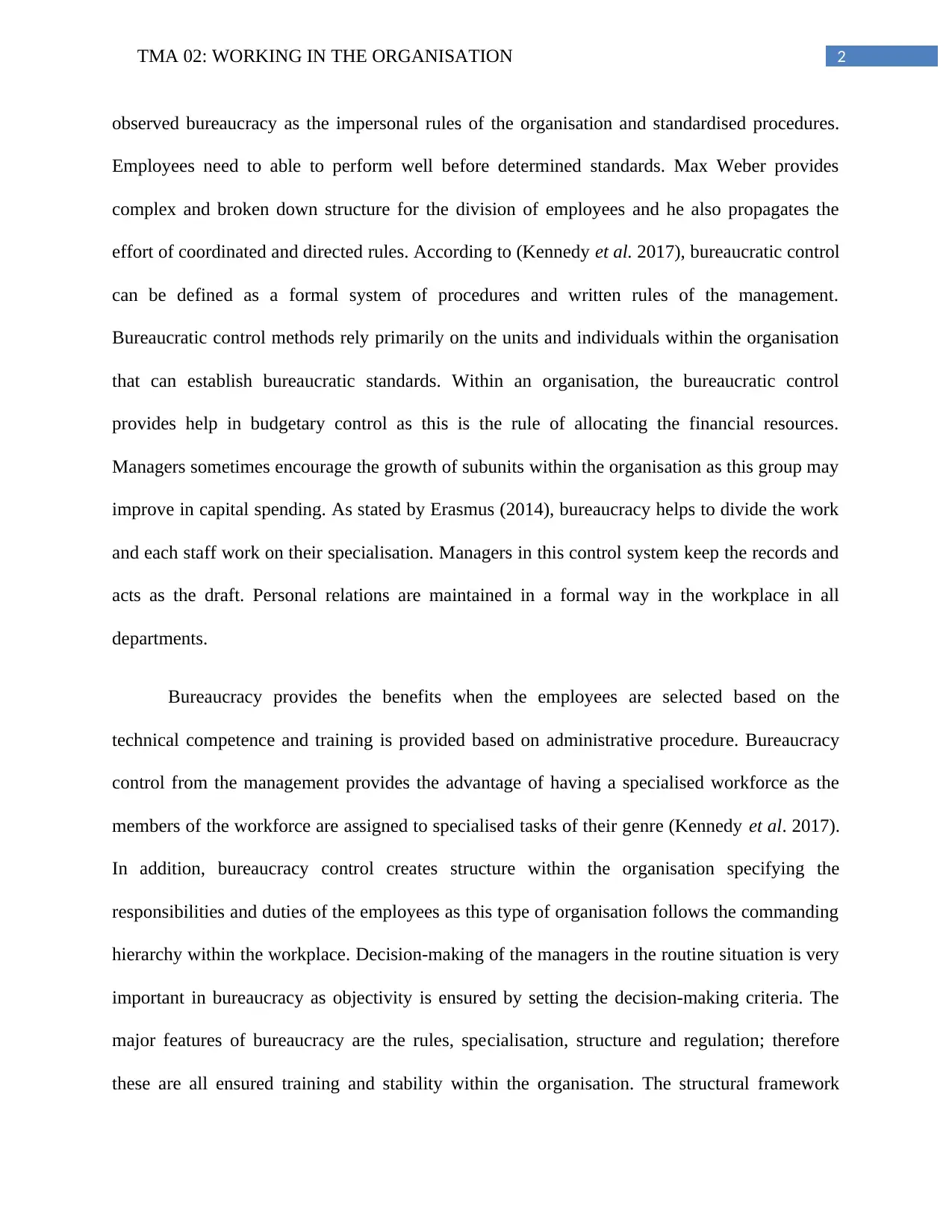
2TMA 02: WORKING IN THE ORGANISATION
observed bureaucracy as the impersonal rules of the organisation and standardised procedures.
Employees need to able to perform well before determined standards. Max Weber provides
complex and broken down structure for the division of employees and he also propagates the
effort of coordinated and directed rules. According to (Kennedy et al. 2017), bureaucratic control
can be defined as a formal system of procedures and written rules of the management.
Bureaucratic control methods rely primarily on the units and individuals within the organisation
that can establish bureaucratic standards. Within an organisation, the bureaucratic control
provides help in budgetary control as this is the rule of allocating the financial resources.
Managers sometimes encourage the growth of subunits within the organisation as this group may
improve in capital spending. As stated by Erasmus (2014), bureaucracy helps to divide the work
and each staff work on their specialisation. Managers in this control system keep the records and
acts as the draft. Personal relations are maintained in a formal way in the workplace in all
departments.
Bureaucracy provides the benefits when the employees are selected based on the
technical competence and training is provided based on administrative procedure. Bureaucracy
control from the management provides the advantage of having a specialised workforce as the
members of the workforce are assigned to specialised tasks of their genre (Kennedy et al. 2017).
In addition, bureaucracy control creates structure within the organisation specifying the
responsibilities and duties of the employees as this type of organisation follows the commanding
hierarchy within the workplace. Decision-making of the managers in the routine situation is very
important in bureaucracy as objectivity is ensured by setting the decision-making criteria. The
major features of bureaucracy are the rules, specialisation, structure and regulation; therefore
these are all ensured training and stability within the organisation. The structural framework
observed bureaucracy as the impersonal rules of the organisation and standardised procedures.
Employees need to able to perform well before determined standards. Max Weber provides
complex and broken down structure for the division of employees and he also propagates the
effort of coordinated and directed rules. According to (Kennedy et al. 2017), bureaucratic control
can be defined as a formal system of procedures and written rules of the management.
Bureaucratic control methods rely primarily on the units and individuals within the organisation
that can establish bureaucratic standards. Within an organisation, the bureaucratic control
provides help in budgetary control as this is the rule of allocating the financial resources.
Managers sometimes encourage the growth of subunits within the organisation as this group may
improve in capital spending. As stated by Erasmus (2014), bureaucracy helps to divide the work
and each staff work on their specialisation. Managers in this control system keep the records and
acts as the draft. Personal relations are maintained in a formal way in the workplace in all
departments.
Bureaucracy provides the benefits when the employees are selected based on the
technical competence and training is provided based on administrative procedure. Bureaucracy
control from the management provides the advantage of having a specialised workforce as the
members of the workforce are assigned to specialised tasks of their genre (Kennedy et al. 2017).
In addition, bureaucracy control creates structure within the organisation specifying the
responsibilities and duties of the employees as this type of organisation follows the commanding
hierarchy within the workplace. Decision-making of the managers in the routine situation is very
important in bureaucracy as objectivity is ensured by setting the decision-making criteria. The
major features of bureaucracy are the rules, specialisation, structure and regulation; therefore
these are all ensured training and stability within the organisation. The structural framework
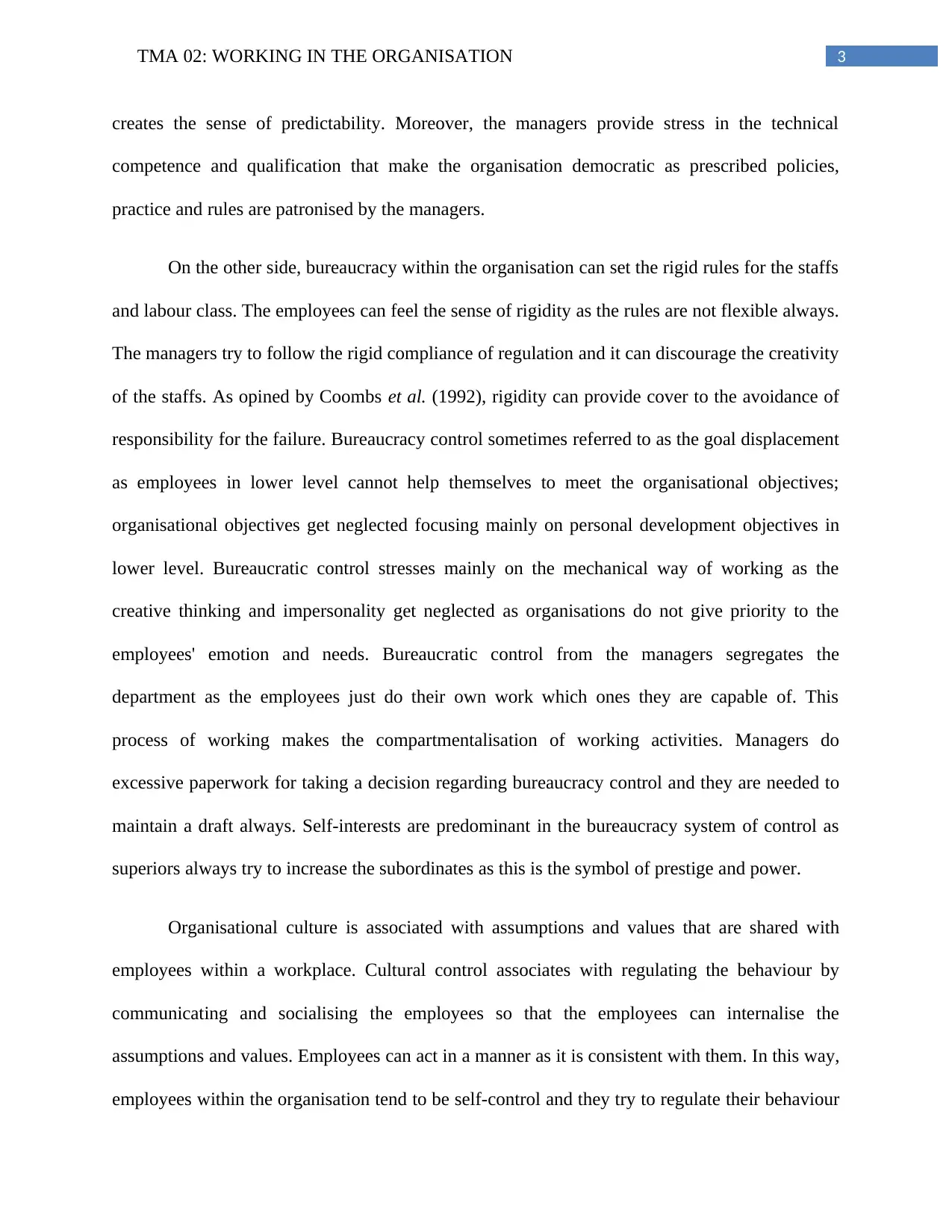
3TMA 02: WORKING IN THE ORGANISATION
creates the sense of predictability. Moreover, the managers provide stress in the technical
competence and qualification that make the organisation democratic as prescribed policies,
practice and rules are patronised by the managers.
On the other side, bureaucracy within the organisation can set the rigid rules for the staffs
and labour class. The employees can feel the sense of rigidity as the rules are not flexible always.
The managers try to follow the rigid compliance of regulation and it can discourage the creativity
of the staffs. As opined by Coombs et al. (1992), rigidity can provide cover to the avoidance of
responsibility for the failure. Bureaucracy control sometimes referred to as the goal displacement
as employees in lower level cannot help themselves to meet the organisational objectives;
organisational objectives get neglected focusing mainly on personal development objectives in
lower level. Bureaucratic control stresses mainly on the mechanical way of working as the
creative thinking and impersonality get neglected as organisations do not give priority to the
employees' emotion and needs. Bureaucratic control from the managers segregates the
department as the employees just do their own work which ones they are capable of. This
process of working makes the compartmentalisation of working activities. Managers do
excessive paperwork for taking a decision regarding bureaucracy control and they are needed to
maintain a draft always. Self-interests are predominant in the bureaucracy system of control as
superiors always try to increase the subordinates as this is the symbol of prestige and power.
Organisational culture is associated with assumptions and values that are shared with
employees within a workplace. Cultural control associates with regulating the behaviour by
communicating and socialising the employees so that the employees can internalise the
assumptions and values. Employees can act in a manner as it is consistent with them. In this way,
employees within the organisation tend to be self-control and they try to regulate their behaviour
creates the sense of predictability. Moreover, the managers provide stress in the technical
competence and qualification that make the organisation democratic as prescribed policies,
practice and rules are patronised by the managers.
On the other side, bureaucracy within the organisation can set the rigid rules for the staffs
and labour class. The employees can feel the sense of rigidity as the rules are not flexible always.
The managers try to follow the rigid compliance of regulation and it can discourage the creativity
of the staffs. As opined by Coombs et al. (1992), rigidity can provide cover to the avoidance of
responsibility for the failure. Bureaucracy control sometimes referred to as the goal displacement
as employees in lower level cannot help themselves to meet the organisational objectives;
organisational objectives get neglected focusing mainly on personal development objectives in
lower level. Bureaucratic control stresses mainly on the mechanical way of working as the
creative thinking and impersonality get neglected as organisations do not give priority to the
employees' emotion and needs. Bureaucratic control from the managers segregates the
department as the employees just do their own work which ones they are capable of. This
process of working makes the compartmentalisation of working activities. Managers do
excessive paperwork for taking a decision regarding bureaucracy control and they are needed to
maintain a draft always. Self-interests are predominant in the bureaucracy system of control as
superiors always try to increase the subordinates as this is the symbol of prestige and power.
Organisational culture is associated with assumptions and values that are shared with
employees within a workplace. Cultural control associates with regulating the behaviour by
communicating and socialising the employees so that the employees can internalise the
assumptions and values. Employees can act in a manner as it is consistent with them. In this way,
employees within the organisation tend to be self-control and they try to regulate their behaviour
Secure Best Marks with AI Grader
Need help grading? Try our AI Grader for instant feedback on your assignments.
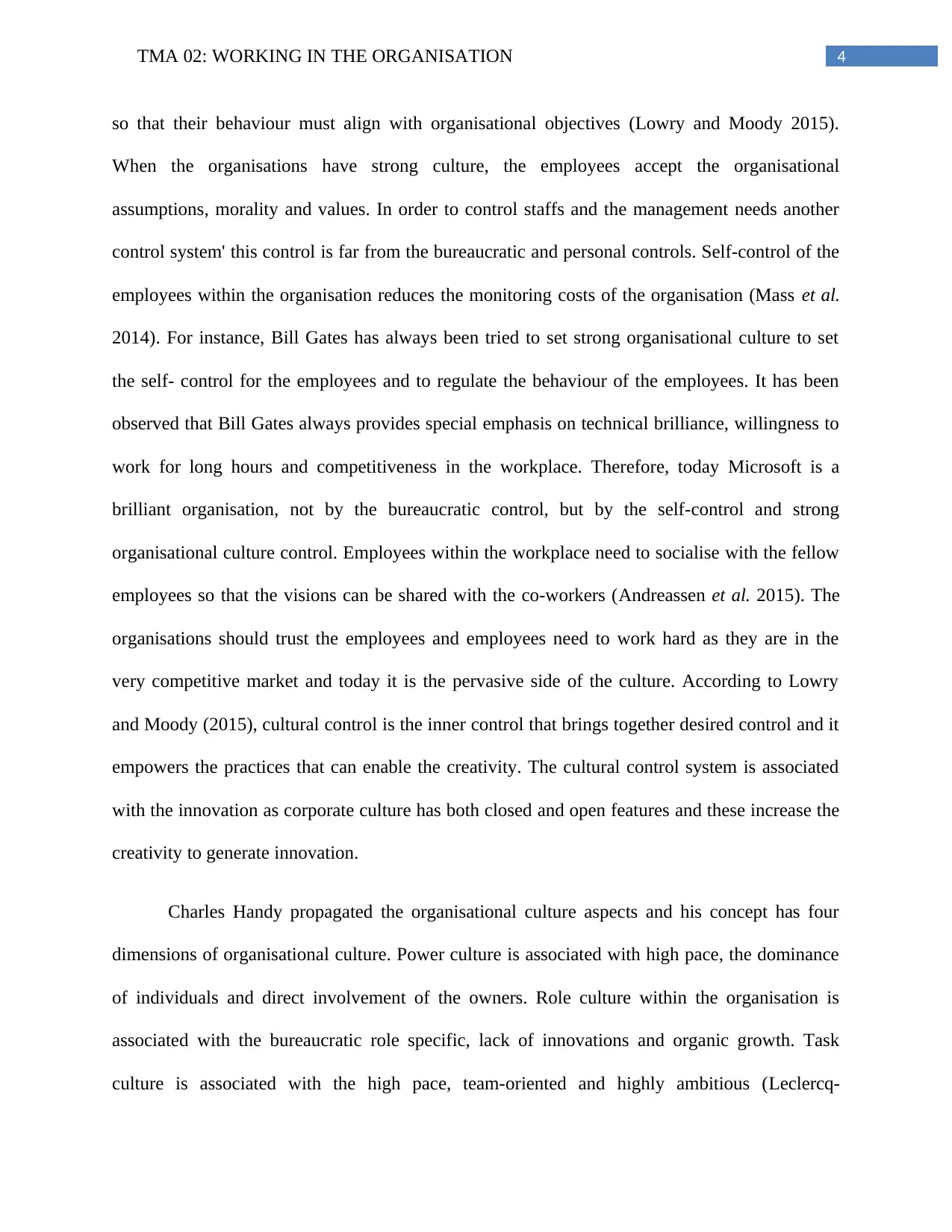
4TMA 02: WORKING IN THE ORGANISATION
so that their behaviour must align with organisational objectives (Lowry and Moody 2015).
When the organisations have strong culture, the employees accept the organisational
assumptions, morality and values. In order to control staffs and the management needs another
control system' this control is far from the bureaucratic and personal controls. Self-control of the
employees within the organisation reduces the monitoring costs of the organisation (Mass et al.
2014). For instance, Bill Gates has always been tried to set strong organisational culture to set
the self- control for the employees and to regulate the behaviour of the employees. It has been
observed that Bill Gates always provides special emphasis on technical brilliance, willingness to
work for long hours and competitiveness in the workplace. Therefore, today Microsoft is a
brilliant organisation, not by the bureaucratic control, but by the self-control and strong
organisational culture control. Employees within the workplace need to socialise with the fellow
employees so that the visions can be shared with the co-workers (Andreassen et al. 2015). The
organisations should trust the employees and employees need to work hard as they are in the
very competitive market and today it is the pervasive side of the culture. According to Lowry
and Moody (2015), cultural control is the inner control that brings together desired control and it
empowers the practices that can enable the creativity. The cultural control system is associated
with the innovation as corporate culture has both closed and open features and these increase the
creativity to generate innovation.
Charles Handy propagated the organisational culture aspects and his concept has four
dimensions of organisational culture. Power culture is associated with high pace, the dominance
of individuals and direct involvement of the owners. Role culture within the organisation is
associated with the bureaucratic role specific, lack of innovations and organic growth. Task
culture is associated with the high pace, team-oriented and highly ambitious (Leclercq-
so that their behaviour must align with organisational objectives (Lowry and Moody 2015).
When the organisations have strong culture, the employees accept the organisational
assumptions, morality and values. In order to control staffs and the management needs another
control system' this control is far from the bureaucratic and personal controls. Self-control of the
employees within the organisation reduces the monitoring costs of the organisation (Mass et al.
2014). For instance, Bill Gates has always been tried to set strong organisational culture to set
the self- control for the employees and to regulate the behaviour of the employees. It has been
observed that Bill Gates always provides special emphasis on technical brilliance, willingness to
work for long hours and competitiveness in the workplace. Therefore, today Microsoft is a
brilliant organisation, not by the bureaucratic control, but by the self-control and strong
organisational culture control. Employees within the workplace need to socialise with the fellow
employees so that the visions can be shared with the co-workers (Andreassen et al. 2015). The
organisations should trust the employees and employees need to work hard as they are in the
very competitive market and today it is the pervasive side of the culture. According to Lowry
and Moody (2015), cultural control is the inner control that brings together desired control and it
empowers the practices that can enable the creativity. The cultural control system is associated
with the innovation as corporate culture has both closed and open features and these increase the
creativity to generate innovation.
Charles Handy propagated the organisational culture aspects and his concept has four
dimensions of organisational culture. Power culture is associated with high pace, the dominance
of individuals and direct involvement of the owners. Role culture within the organisation is
associated with the bureaucratic role specific, lack of innovations and organic growth. Task
culture is associated with the high pace, team-oriented and highly ambitious (Leclercq-
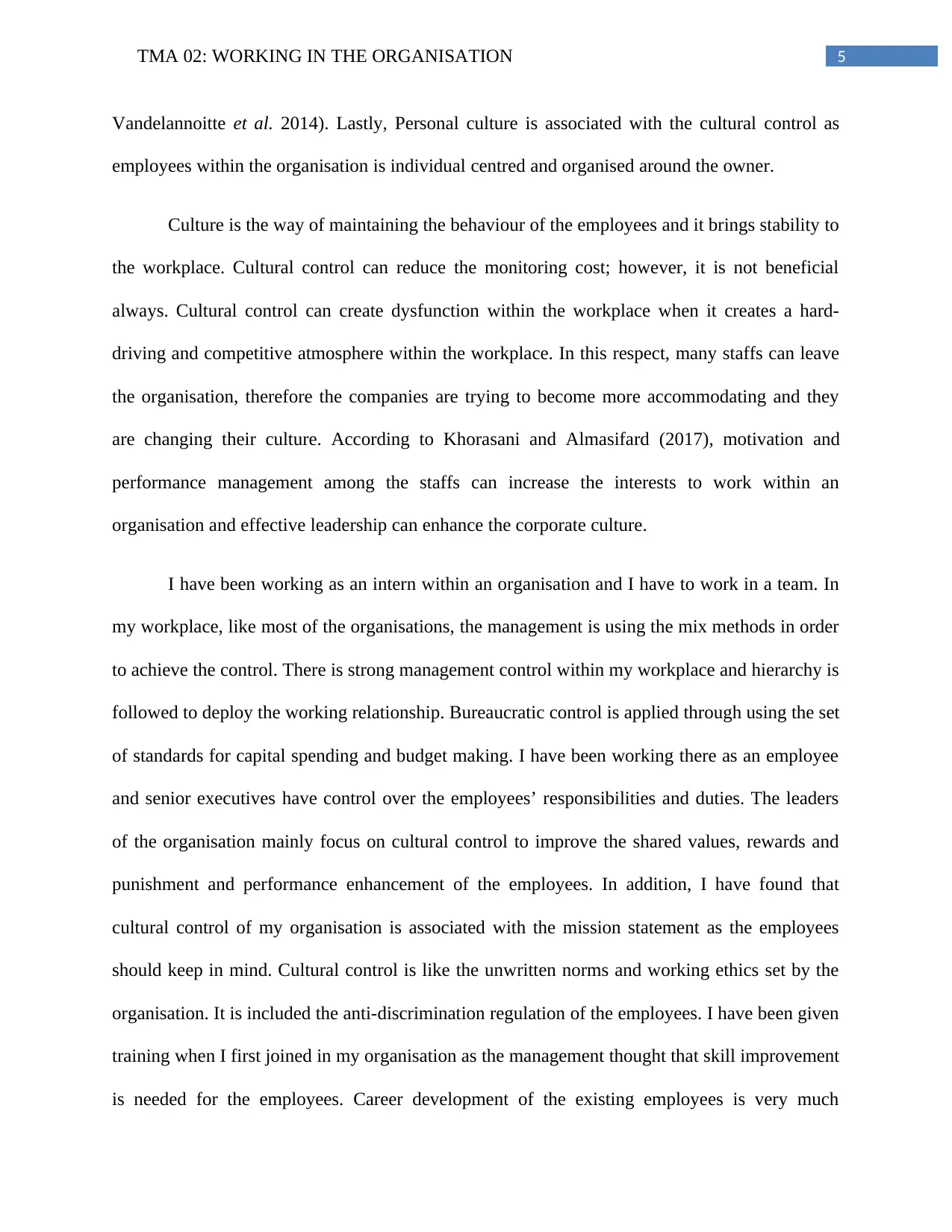
5TMA 02: WORKING IN THE ORGANISATION
Vandelannoitte et al. 2014). Lastly, Personal culture is associated with the cultural control as
employees within the organisation is individual centred and organised around the owner.
Culture is the way of maintaining the behaviour of the employees and it brings stability to
the workplace. Cultural control can reduce the monitoring cost; however, it is not beneficial
always. Cultural control can create dysfunction within the workplace when it creates a hard-
driving and competitive atmosphere within the workplace. In this respect, many staffs can leave
the organisation, therefore the companies are trying to become more accommodating and they
are changing their culture. According to Khorasani and Almasifard (2017), motivation and
performance management among the staffs can increase the interests to work within an
organisation and effective leadership can enhance the corporate culture.
I have been working as an intern within an organisation and I have to work in a team. In
my workplace, like most of the organisations, the management is using the mix methods in order
to achieve the control. There is strong management control within my workplace and hierarchy is
followed to deploy the working relationship. Bureaucratic control is applied through using the set
of standards for capital spending and budget making. I have been working there as an employee
and senior executives have control over the employees’ responsibilities and duties. The leaders
of the organisation mainly focus on cultural control to improve the shared values, rewards and
punishment and performance enhancement of the employees. In addition, I have found that
cultural control of my organisation is associated with the mission statement as the employees
should keep in mind. Cultural control is like the unwritten norms and working ethics set by the
organisation. It is included the anti-discrimination regulation of the employees. I have been given
training when I first joined in my organisation as the management thought that skill improvement
is needed for the employees. Career development of the existing employees is very much
Vandelannoitte et al. 2014). Lastly, Personal culture is associated with the cultural control as
employees within the organisation is individual centred and organised around the owner.
Culture is the way of maintaining the behaviour of the employees and it brings stability to
the workplace. Cultural control can reduce the monitoring cost; however, it is not beneficial
always. Cultural control can create dysfunction within the workplace when it creates a hard-
driving and competitive atmosphere within the workplace. In this respect, many staffs can leave
the organisation, therefore the companies are trying to become more accommodating and they
are changing their culture. According to Khorasani and Almasifard (2017), motivation and
performance management among the staffs can increase the interests to work within an
organisation and effective leadership can enhance the corporate culture.
I have been working as an intern within an organisation and I have to work in a team. In
my workplace, like most of the organisations, the management is using the mix methods in order
to achieve the control. There is strong management control within my workplace and hierarchy is
followed to deploy the working relationship. Bureaucratic control is applied through using the set
of standards for capital spending and budget making. I have been working there as an employee
and senior executives have control over the employees’ responsibilities and duties. The leaders
of the organisation mainly focus on cultural control to improve the shared values, rewards and
punishment and performance enhancement of the employees. In addition, I have found that
cultural control of my organisation is associated with the mission statement as the employees
should keep in mind. Cultural control is like the unwritten norms and working ethics set by the
organisation. It is included the anti-discrimination regulation of the employees. I have been given
training when I first joined in my organisation as the management thought that skill improvement
is needed for the employees. Career development of the existing employees is very much
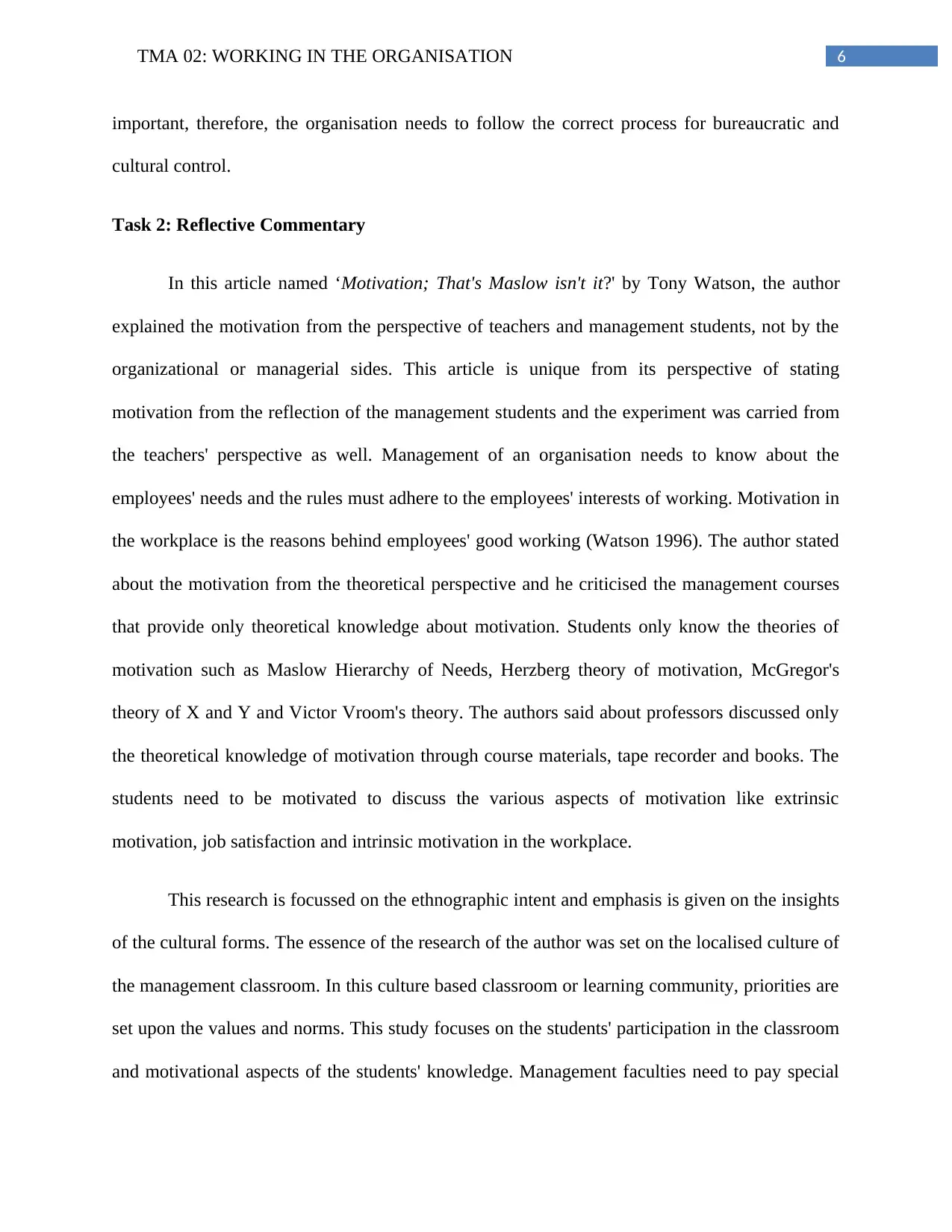
6TMA 02: WORKING IN THE ORGANISATION
important, therefore, the organisation needs to follow the correct process for bureaucratic and
cultural control.
Task 2: Reflective Commentary
In this article named ‘Motivation; That's Maslow isn't it?' by Tony Watson, the author
explained the motivation from the perspective of teachers and management students, not by the
organizational or managerial sides. This article is unique from its perspective of stating
motivation from the reflection of the management students and the experiment was carried from
the teachers' perspective as well. Management of an organisation needs to know about the
employees' needs and the rules must adhere to the employees' interests of working. Motivation in
the workplace is the reasons behind employees' good working (Watson 1996). The author stated
about the motivation from the theoretical perspective and he criticised the management courses
that provide only theoretical knowledge about motivation. Students only know the theories of
motivation such as Maslow Hierarchy of Needs, Herzberg theory of motivation, McGregor's
theory of X and Y and Victor Vroom's theory. The authors said about professors discussed only
the theoretical knowledge of motivation through course materials, tape recorder and books. The
students need to be motivated to discuss the various aspects of motivation like extrinsic
motivation, job satisfaction and intrinsic motivation in the workplace.
This research is focussed on the ethnographic intent and emphasis is given on the insights
of the cultural forms. The essence of the research of the author was set on the localised culture of
the management classroom. In this culture based classroom or learning community, priorities are
set upon the values and norms. This study focuses on the students' participation in the classroom
and motivational aspects of the students' knowledge. Management faculties need to pay special
important, therefore, the organisation needs to follow the correct process for bureaucratic and
cultural control.
Task 2: Reflective Commentary
In this article named ‘Motivation; That's Maslow isn't it?' by Tony Watson, the author
explained the motivation from the perspective of teachers and management students, not by the
organizational or managerial sides. This article is unique from its perspective of stating
motivation from the reflection of the management students and the experiment was carried from
the teachers' perspective as well. Management of an organisation needs to know about the
employees' needs and the rules must adhere to the employees' interests of working. Motivation in
the workplace is the reasons behind employees' good working (Watson 1996). The author stated
about the motivation from the theoretical perspective and he criticised the management courses
that provide only theoretical knowledge about motivation. Students only know the theories of
motivation such as Maslow Hierarchy of Needs, Herzberg theory of motivation, McGregor's
theory of X and Y and Victor Vroom's theory. The authors said about professors discussed only
the theoretical knowledge of motivation through course materials, tape recorder and books. The
students need to be motivated to discuss the various aspects of motivation like extrinsic
motivation, job satisfaction and intrinsic motivation in the workplace.
This research is focussed on the ethnographic intent and emphasis is given on the insights
of the cultural forms. The essence of the research of the author was set on the localised culture of
the management classroom. In this culture based classroom or learning community, priorities are
set upon the values and norms. This study focuses on the students' participation in the classroom
and motivational aspects of the students' knowledge. Management faculties need to pay special
Paraphrase This Document
Need a fresh take? Get an instant paraphrase of this document with our AI Paraphraser
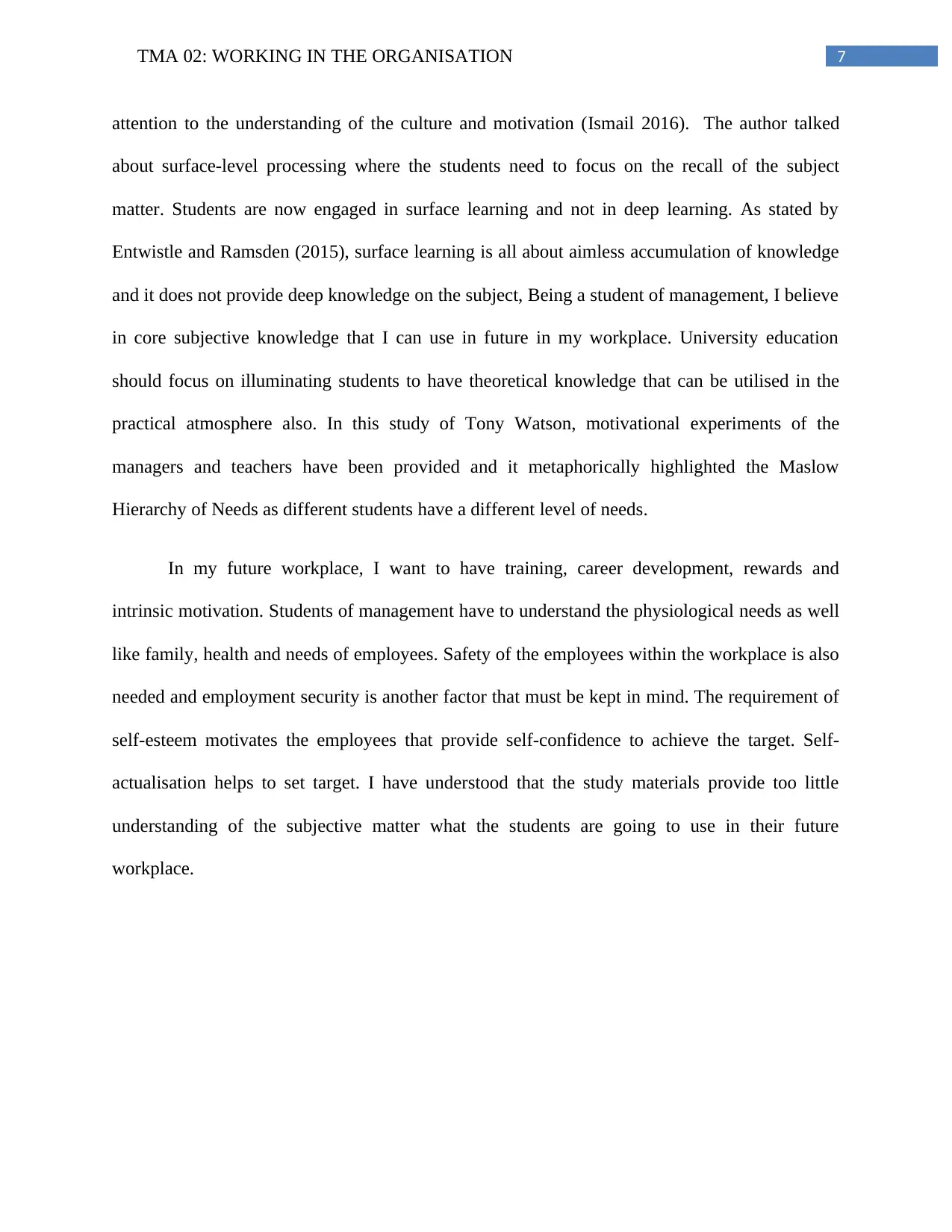
7TMA 02: WORKING IN THE ORGANISATION
attention to the understanding of the culture and motivation (Ismail 2016). The author talked
about surface-level processing where the students need to focus on the recall of the subject
matter. Students are now engaged in surface learning and not in deep learning. As stated by
Entwistle and Ramsden (2015), surface learning is all about aimless accumulation of knowledge
and it does not provide deep knowledge on the subject, Being a student of management, I believe
in core subjective knowledge that I can use in future in my workplace. University education
should focus on illuminating students to have theoretical knowledge that can be utilised in the
practical atmosphere also. In this study of Tony Watson, motivational experiments of the
managers and teachers have been provided and it metaphorically highlighted the Maslow
Hierarchy of Needs as different students have a different level of needs.
In my future workplace, I want to have training, career development, rewards and
intrinsic motivation. Students of management have to understand the physiological needs as well
like family, health and needs of employees. Safety of the employees within the workplace is also
needed and employment security is another factor that must be kept in mind. The requirement of
self-esteem motivates the employees that provide self-confidence to achieve the target. Self-
actualisation helps to set target. I have understood that the study materials provide too little
understanding of the subjective matter what the students are going to use in their future
workplace.
attention to the understanding of the culture and motivation (Ismail 2016). The author talked
about surface-level processing where the students need to focus on the recall of the subject
matter. Students are now engaged in surface learning and not in deep learning. As stated by
Entwistle and Ramsden (2015), surface learning is all about aimless accumulation of knowledge
and it does not provide deep knowledge on the subject, Being a student of management, I believe
in core subjective knowledge that I can use in future in my workplace. University education
should focus on illuminating students to have theoretical knowledge that can be utilised in the
practical atmosphere also. In this study of Tony Watson, motivational experiments of the
managers and teachers have been provided and it metaphorically highlighted the Maslow
Hierarchy of Needs as different students have a different level of needs.
In my future workplace, I want to have training, career development, rewards and
intrinsic motivation. Students of management have to understand the physiological needs as well
like family, health and needs of employees. Safety of the employees within the workplace is also
needed and employment security is another factor that must be kept in mind. The requirement of
self-esteem motivates the employees that provide self-confidence to achieve the target. Self-
actualisation helps to set target. I have understood that the study materials provide too little
understanding of the subjective matter what the students are going to use in their future
workplace.
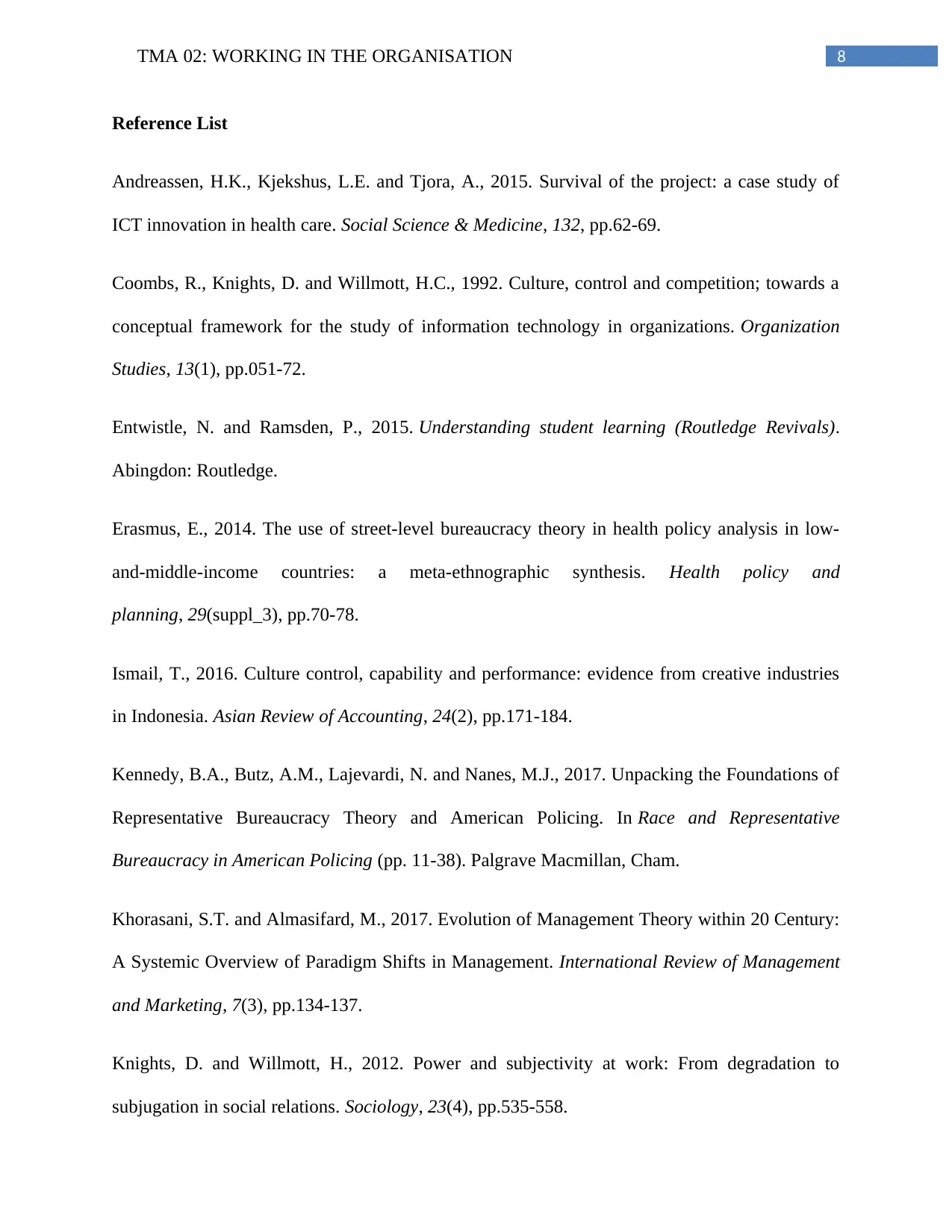
8TMA 02: WORKING IN THE ORGANISATION
Reference List
Andreassen, H.K., Kjekshus, L.E. and Tjora, A., 2015. Survival of the project: a case study of
ICT innovation in health care. Social Science & Medicine, 132, pp.62-69.
Coombs, R., Knights, D. and Willmott, H.C., 1992. Culture, control and competition; towards a
conceptual framework for the study of information technology in organizations. Organization
Studies, 13(1), pp.051-72.
Entwistle, N. and Ramsden, P., 2015. Understanding student learning (Routledge Revivals).
Abingdon: Routledge.
Erasmus, E., 2014. The use of street-level bureaucracy theory in health policy analysis in low-
and-middle-income countries: a meta-ethnographic synthesis. Health policy and
planning, 29(suppl_3), pp.70-78.
Ismail, T., 2016. Culture control, capability and performance: evidence from creative industries
in Indonesia. Asian Review of Accounting, 24(2), pp.171-184.
Kennedy, B.A., Butz, A.M., Lajevardi, N. and Nanes, M.J., 2017. Unpacking the Foundations of
Representative Bureaucracy Theory and American Policing. In Race and Representative
Bureaucracy in American Policing (pp. 11-38). Palgrave Macmillan, Cham.
Khorasani, S.T. and Almasifard, M., 2017. Evolution of Management Theory within 20 Century:
A Systemic Overview of Paradigm Shifts in Management. International Review of Management
and Marketing, 7(3), pp.134-137.
Knights, D. and Willmott, H., 2012. Power and subjectivity at work: From degradation to
subjugation in social relations. Sociology, 23(4), pp.535-558.
Reference List
Andreassen, H.K., Kjekshus, L.E. and Tjora, A., 2015. Survival of the project: a case study of
ICT innovation in health care. Social Science & Medicine, 132, pp.62-69.
Coombs, R., Knights, D. and Willmott, H.C., 1992. Culture, control and competition; towards a
conceptual framework for the study of information technology in organizations. Organization
Studies, 13(1), pp.051-72.
Entwistle, N. and Ramsden, P., 2015. Understanding student learning (Routledge Revivals).
Abingdon: Routledge.
Erasmus, E., 2014. The use of street-level bureaucracy theory in health policy analysis in low-
and-middle-income countries: a meta-ethnographic synthesis. Health policy and
planning, 29(suppl_3), pp.70-78.
Ismail, T., 2016. Culture control, capability and performance: evidence from creative industries
in Indonesia. Asian Review of Accounting, 24(2), pp.171-184.
Kennedy, B.A., Butz, A.M., Lajevardi, N. and Nanes, M.J., 2017. Unpacking the Foundations of
Representative Bureaucracy Theory and American Policing. In Race and Representative
Bureaucracy in American Policing (pp. 11-38). Palgrave Macmillan, Cham.
Khorasani, S.T. and Almasifard, M., 2017. Evolution of Management Theory within 20 Century:
A Systemic Overview of Paradigm Shifts in Management. International Review of Management
and Marketing, 7(3), pp.134-137.
Knights, D. and Willmott, H., 2012. Power and subjectivity at work: From degradation to
subjugation in social relations. Sociology, 23(4), pp.535-558.
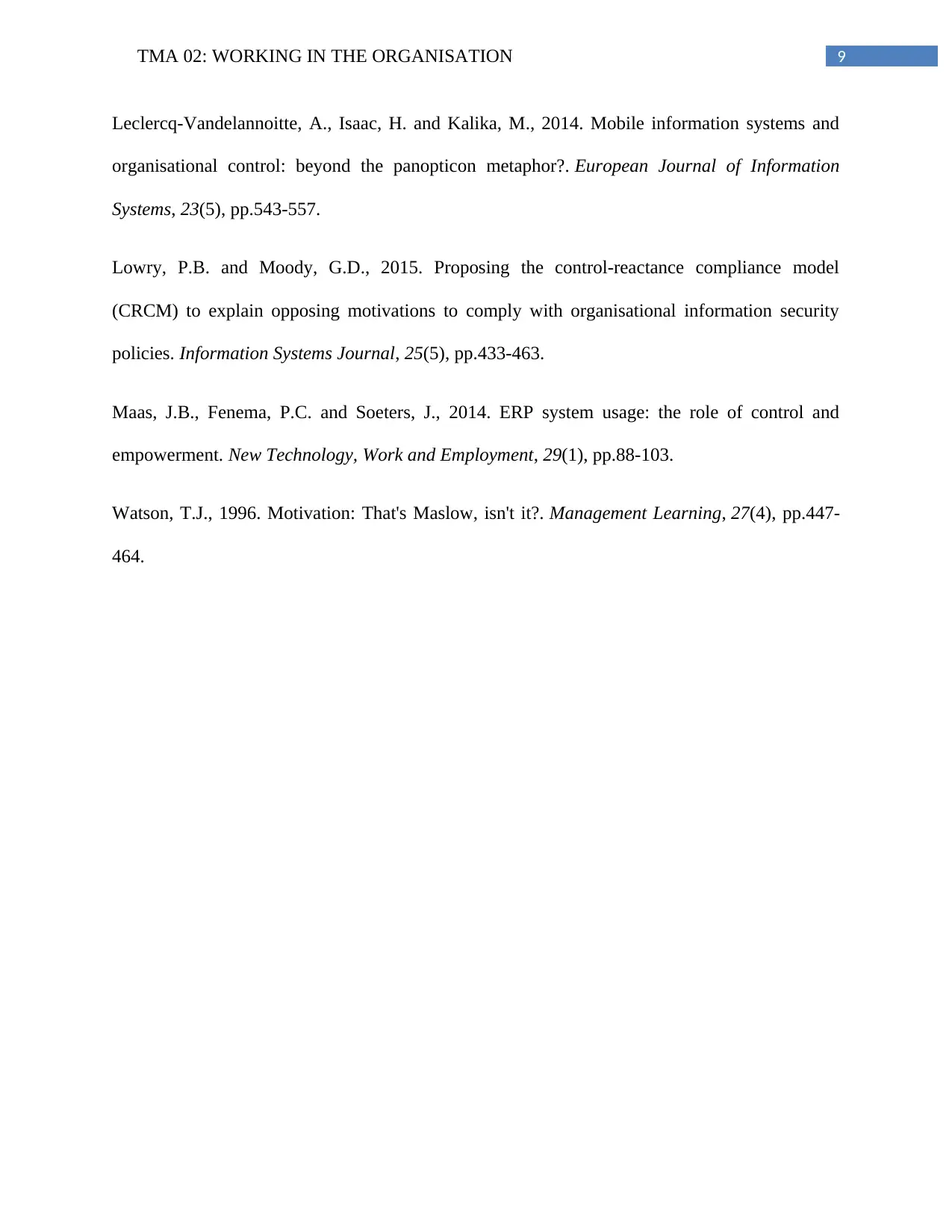
9TMA 02: WORKING IN THE ORGANISATION
Leclercq-Vandelannoitte, A., Isaac, H. and Kalika, M., 2014. Mobile information systems and
organisational control: beyond the panopticon metaphor?. European Journal of Information
Systems, 23(5), pp.543-557.
Lowry, P.B. and Moody, G.D., 2015. Proposing the control‐reactance compliance model
(CRCM) to explain opposing motivations to comply with organisational information security
policies. Information Systems Journal, 25(5), pp.433-463.
Maas, J.B., Fenema, P.C. and Soeters, J., 2014. ERP system usage: the role of control and
empowerment. New Technology, Work and Employment, 29(1), pp.88-103.
Watson, T.J., 1996. Motivation: That's Maslow, isn't it?. Management Learning, 27(4), pp.447-
464.
Leclercq-Vandelannoitte, A., Isaac, H. and Kalika, M., 2014. Mobile information systems and
organisational control: beyond the panopticon metaphor?. European Journal of Information
Systems, 23(5), pp.543-557.
Lowry, P.B. and Moody, G.D., 2015. Proposing the control‐reactance compliance model
(CRCM) to explain opposing motivations to comply with organisational information security
policies. Information Systems Journal, 25(5), pp.433-463.
Maas, J.B., Fenema, P.C. and Soeters, J., 2014. ERP system usage: the role of control and
empowerment. New Technology, Work and Employment, 29(1), pp.88-103.
Watson, T.J., 1996. Motivation: That's Maslow, isn't it?. Management Learning, 27(4), pp.447-
464.
1 out of 10
Related Documents
Your All-in-One AI-Powered Toolkit for Academic Success.
+13062052269
info@desklib.com
Available 24*7 on WhatsApp / Email
![[object Object]](/_next/static/media/star-bottom.7253800d.svg)
Unlock your academic potential
© 2024 | Zucol Services PVT LTD | All rights reserved.





